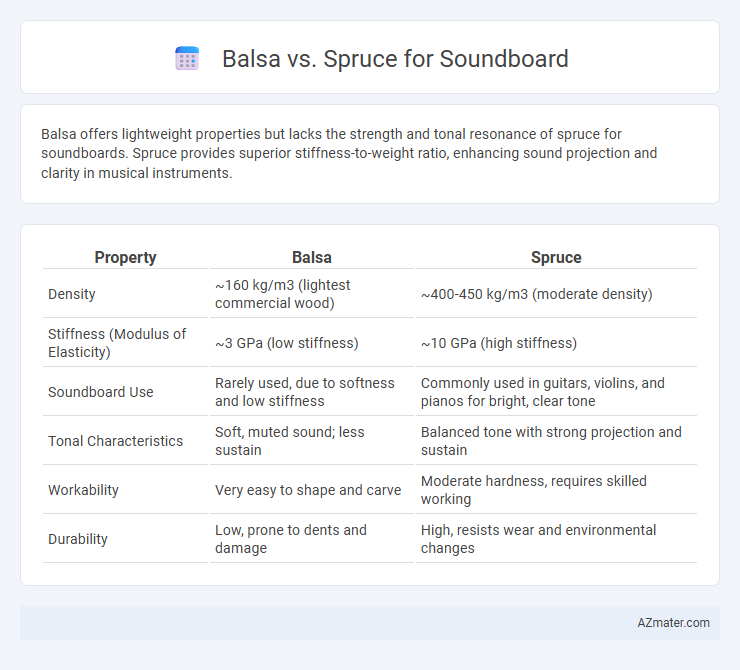Balsa offers lightweight properties but lacks the strength and tonal resonance of spruce for soundboards. Spruce provides superior stiffness-to-weight ratio, enhancing sound projection and clarity in musical instruments.
Table of Comparison
| Property | Balsa | Spruce |
|---|---|---|
| Density | ~160 kg/m3 (lightest commercial wood) | ~400-450 kg/m3 (moderate density) |
| Stiffness (Modulus of Elasticity) | ~3 GPa (low stiffness) | ~10 GPa (high stiffness) |
| Soundboard Use | Rarely used, due to softness and low stiffness | Commonly used in guitars, violins, and pianos for bright, clear tone |
| Tonal Characteristics | Soft, muted sound; less sustain | Balanced tone with strong projection and sustain |
| Workability | Very easy to shape and carve | Moderate hardness, requires skilled working |
| Durability | Low, prone to dents and damage | High, resists wear and environmental changes |
Introduction to Soundboard Tonewoods
Soundboard tonewoods like balsa and spruce significantly influence acoustic guitar sound quality. Balsa offers a lightweight structure with a soft, responsive nature, producing warm, mellow tones that emphasize midrange frequencies. Spruce, especially Sitka or Engelmann variants, provides a balanced stiffness-to-weight ratio, resulting in bright, clear projection and strong dynamic range favored by many luthiers.
Overview of Balsa and Spruce
Balsa and Spruce are popular tonewoods used for soundboards, prized for their distinct acoustic properties. Spruce is known for its high stiffness-to-weight ratio, producing bright, clear, and resonant tones favored in guitars and pianos. Balsa is much lighter and softer, offering excellent damping and a warmer, more mellow sound, though it lacks the projection and sustain typical of spruce.
Physical Properties Comparison
Balsa wood offers exceptionally low density, typically around 160 kg/m3, resulting in superior lightweight characteristics compared to spruce, which has a density ranging from 350 to 450 kg/m3. Spruce exhibits higher stiffness-to-weight ratios, with a modulus of elasticity between 10 to 12 GPa, making it more resilient and stable under tension, essential for soundboard vibration and tonal projection. Balsa's softness and lower hardness (around 130 N/mm2) reduce durability and can affect soundboard longevity, while spruce's greater hardness (about 400 N/mm2) ensures enhanced structural integrity in musical instrument construction.
Acoustic Characteristics of Balsa
Balsa wood is renowned for its exceptional lightness and stiffness, offering superior resonance and quick response in soundboards compared to denser woods like spruce. Its low density enhances sound projection and clarity, making it ideal for instruments requiring bright, articulate tones. The open grain structure of balsa also contributes to its unique acoustic properties, providing a warm yet lively sound signature favored in certain guitar and ukulele designs.
Acoustic Characteristics of Spruce
Spruce is widely preferred for soundboards due to its excellent strength-to-weight ratio, providing a bright, clear tone with strong projection and dynamic range. Its fine, straight grain structure enhances resonance and sustain, resulting in a balanced sound with rich harmonics. Compared to balsa, spruce offers superior stiffness and elasticity, making it ideal for instruments requiring precise tonal clarity and responsiveness.
Durability and Longevity
Spruce soundboards offer superior durability and longevity compared to balsa, as their dense grain structure resists wear and environmental changes effectively. Balsa, while lightweight, tends to be softer and more prone to dents, reducing its lifespan under regular use. Musicians seeking a long-lasting soundboard typically prefer spruce for its reliable performance over time.
Weight and Workability
Balsa is significantly lighter than spruce, making it an excellent choice for soundboards where minimizing weight is crucial, such as in travel or student instruments. Spruce offers superior workability with a fine, straight grain that provides strength and responsiveness, enabling precise carving and shaping. Both woods deliver good tonal qualities, but balsa's low density enhances resonance while spruce's durability ensures a longer-lasting soundboard.
Cost and Availability
Balsa wood offers a lower cost and faster availability compared to spruce, making it a budget-friendly option for soundboards in musical instruments. Spruce, while generally more expensive, is preferred for its superior tonal qualities and consistent availability from specialized suppliers. Cost efficiency and regional sourcing heavily influence the choice between balsa and spruce in soundboard construction.
Suitability for Different Instrument Types
Balsa wood, known for its exceptionally light weight and softness, is ideal for smaller, delicate instruments such as ukuleles and travel guitars where a responsive top is crucial for enhanced sound projection and warmth. Spruce, particularly Sitka or Engelmann varieties, offers superior strength-to-weight ratio and stiffness, making it the preferred choice for larger instruments like classical and steel-string acoustic guitars, as well as violins, where clarity, volume, and dynamic range are essential. The tonal characteristics of spruce provide a balanced brightness and sustain, while balsa delivers a softer, mellower sound suited for instruments requiring gentle responsiveness over high volume.
Choosing the Right Wood for Your Soundboard
Choosing the right wood for your soundboard significantly impacts the tonal quality and resonance of your instrument. Balsa offers exceptional lightness and responsiveness, creating a bright, lively sound, while spruce provides a balanced mix of strength and elasticity, leading to a warm, rich tone favored in many high-end guitars and pianos. Factors such as wood density, stiffness-to-weight ratio, and grain structure determine how these materials influence sound projection, sustain, and overall acoustic performance.

Infographic: Balsa vs Spruce for Soundboard
 azmater.com
azmater.com